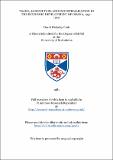Files in this item
Trade, agriculture and industrialisation in the economic development of Ghana, 1951-1972
Item metadata
| dc.contributor.advisor | Hay, Ronald S. | |
| dc.contributor.author | Prah, David Wolseley | |
| dc.coverage.spatial | 389 p. | en_US |
| dc.date.accessioned | 2018-07-12T08:33:59Z | |
| dc.date.available | 2018-07-12T08:33:59Z | |
| dc.date.issued | 1981 | |
| dc.identifier.uri | https://hdl.handle.net/10023/15281 | |
| dc.description.abstract | By 1951 Ghana had developed into a primary produce exporter of some significance; its per capita income was one of the highest in tropical Africa. At the beginning of that year a ten-year development plan was implemented and shortly afterwards the country, incidentally, was granted internal self-government, an event which brought a nationalist party, the Convention Peoples Party (CPP), into office. Ghana's prosperity through the export trade has depended largely on cocoa, which at the beginning of the 1950s constituted more than 50 per cent of the value of the country's total exports. Because the crop had been noted for its high price instability, there was much talk in the country about the need to diversify agricultural output and the agricultural produce entering the export trade. Under the nationalist government the amount actually spent on the industrialisation programme represented an increasing percentage in the series of development plans which were implemented as from 1951: 3.5 per cent under the 1951 Plan; 8.1 per cent under the 1957-59 consolidated Plan and 15.3 per cent under the 2nd Development plan which began in 1959. On the other hand the amount spent on agriculture under each of the plans was about 5 per cent of the total expenditure. More importantly, with respect to agriculture the amount spent was a decreasing proportion of the planned estimates. Under the plans the Government failed either to expand or diversify the agricultural sector and as a result export earnings became stagnant after the mid-50's. In addition the agricultural sector failed to produce more food for the increasing population in the non-agricultural sectors and adequate raw materials for the nascent industrial sector. By the beginning of the 60's the high rate of industrialisation and the stagnant export earnings had resulted in the near depletion of the country's foreign exchange reserves which were accumulated mostly during and immediately after the second world war: Not desiring to reduce the tempo of industrialisation, the CPP Government imposed a series of controls in order to curb private consumption. At the same time the Government entered into wide range of supplier credit agreements mostly for industrial projects. The supplier financed manufacturing projects depends heavily on imported in-puts and were almost all "turn-key" projects. In the face of import controls most of them under-utilised their capacity and became high cost by world market prices. By 1966 Ghana's industrialisation programme had got the country into large foreign debt and in view of its stagnant agricultural sector there was increasing dependence on imported food. The price of cocoa fell steadily on the world market contrary to the expectation of the Government and the balance of payments worsened. The CPP government was overthrown in early 1966 and the new government that came into office, the National Liberation Council adopted different measures to rehabilitate the economy, especially by cancelling prestigious projects and reducing the central governments expenditure so as to bring it in line with its revenue. The other measures adopted included the devaluation of the national currency by 30 per cent in 1967, the adoption of a two-year development plan which included expansion and diversification of the agricultural sector and a moderate trade liberalisation alongside the budgeting of imports. Cocoa prices improved on the world market after 1966 and mainly for this reason the measures of the NLC were moderately successful; the balance of trade deficits, for example, narrowed from year to year. In 1969 the Busia civilian government was voted into office and soon embarked on a massive import liberalisation. The government also continued with the agricultural policy of the regime it replaced. With high cocoa prices prevailing on the world market all went well with the Busia government massive liberalisation measure, but throughout 1971 cocoa plunged steadily and the balance of trade deficits widened. The Government was forced to devalue again by nearly 40 per cent in December and brought about economic hardship and another coup. The new military government the National Liberation Council immediately imposed trade controls, partially revalued the currency but continued with the agriculture policy of its predecessors by adopting an "Operation Feed Yourself" slogan. (Abstract shortened by ProQuest.) | en_US |
| dc.language.iso | en | en_US |
| dc.publisher | University of St Andrews | |
| dc.subject.lcc | HC517.G5P8 | |
| dc.subject.lcsh | Ghana--Economic conditions | en |
| dc.title | Trade, agriculture and industrialisation in the economic development of Ghana, 1951-1972 | en_US |
| dc.type | Thesis | en_US |
| dc.type.qualificationlevel | Masters | en_US |
| dc.type.qualificationname | MPhil Master of Philosophy | en_US |
| dc.publisher.institution | The University of St Andrews | en_US |
This item appears in the following Collection(s)
Items in the St Andrews Research Repository are protected by copyright, with all rights reserved, unless otherwise indicated.

